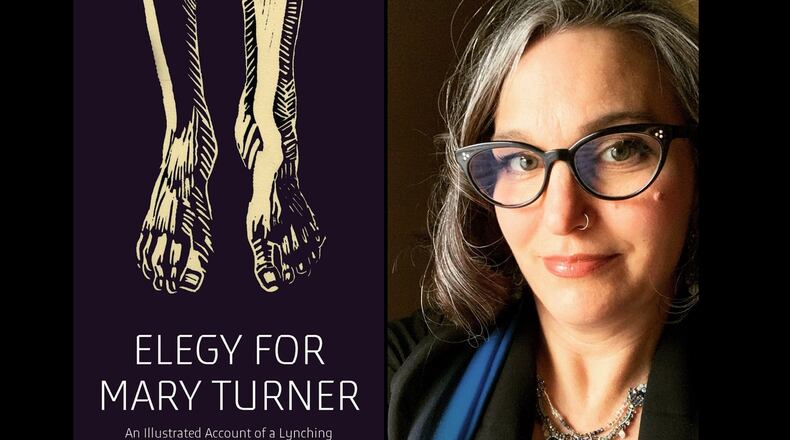How Mary Turner and her baby met their end along the edge of the Little River near Valdosta almost 93 years ago defines horror.
The details repel: lynch mob, oil, gasoline, rope, knife, whimper, bullets. And yet, maybe because of their murderers’ depravity and the notoriety surrounding the Turners’ killing, artists have reckoned with the unspeakable for as long as the Turners have been dead.
Sculpture, books, poetry, even a jazz requiem have either directly referenced or been inspired by the events of May 19, 1918. That day Mary Turner, eight months pregnant and less than 24-hours a widow — the mob had lynched her husband, Hayes, the day before — did something forbidden in the segregated South. She challenged white supremacy. She declared her husband’s innocence in the murder of a local white plantation owner and promised to seek justice against the white men who’d hung her husband from a tree and left his body to rot.
As The Atlanta Journal and The Atlanta Constitution reported at the time, the mob “took exception to her remarks, as well as her attitude.” She was a Black woman who spoke her mind and for that the mob decided she deserved a lesson.
Now comes Rachel Marie-Crane Williams’ book, “Elegy for Mary Turner: An Illustrated Account of a Lynching.” It retells the story in a manner at once unflinching, and, at turns, delicate. The delicacy is owed to Williams’ rendering. The book resembles a vintage scrapbook or diary, perhaps discovered years ago in an old chest of drawers by a descendant of the madness, then placed in a box and shoved under a bed because its contents were abominable.
The book’s pages appear yellowed. Haphazard strips of transparent tape secure postcards of Valdosta as it appeared in the early 1900s: rural, lanes of whitewashed clapboard houses with broad porches, a rutted, dirt main street.
From there Williams unspools the story in passages written in cursive perhaps with an old fountain pen, given the occasional splotches and smears within the text. But Williams, an associate professor of art and art history at the University of Iowa, actually scripted the entries with her own hand. She also created the images that illustrate how nearly a dozen Black men, Mary Turner and her baby came to be lynched.
Williams, who also heads the university’s painting and drawing program, draws her account directly from a report by then-NAACP investigator Walter White. White’s searing document, “The Work of the Mob,” details the week-long killing frenzy that overtook Lowndes and Brooks counties after a Black man named Sidney Johnson shot plantation owner, Hampton Smith. The shooting was retribution for a beating Johnson received at the hands of Smith over a wage dispute. Johnson also shot Smith’s wife. She lived. Her husband died.
A mob of white men and boys gathered to find Johnson but killed at least 10 Black men during the hunt. Hayes Turner was one. For a few chapters, apart from the initial postcards and maps, images are black on sepia paper. As bodies are discovered — drowned, castrated, roasted or riddled with bullets and hanging from trees — color emerges: the watery blue of a dead, glassy eye; the brown of bloated skin or gray of dead leaves. The subtle progression of color builds a sense of dread. It’s obvious red is imminent. But what is the twining mass bordering a page near the book’s middle? A vine, a rope or another ligature the brain does not want to register?
By the time Mary Turner is captured and led to that remote spot along the Little River by a jeering mob ― even if a reader knows what comes next ― it’s hard not to wonder why Williams felt compelled to make us see this terror. Turner is hung upside down from a tree, set on fire, her womb sliced open, her baby’s skull deliberately crushed under the heel of a murderer’s boot, her remains pocked with hundreds of bullets. The words are hard to digest. The images, more so. Especially now when concerns over the glorification of Black pain are legitimate. From Tamir Rice to Eric Garner to Philando Castile to George Floyd, we have spent nearly a decade watching Black people die violently.
Williams does not answer this directly. Instead, she includes a foreword from noted police-abolition activist Mariame Kaba, an afterword by lynching historian and author Julie Buckner Armstrong and a postscript by Hayes and Mary Turner’s great-grand-nephew C. Tyrone Forehand. They say the white supremacy, misogyny and brutality Turner faced is also of this moment.
Although no one was charged in Turner’s murder, Williams lists some of the alleged killers, their names revealed to White by a confidential informant. She says royalties from the book will go to The National Center for Civil and Human Rights in Atlanta. It is not justice, but it is something.
In the book’s foreword, Williams also lists the 141 Black women who were lynched between 1886 and 1957. Seventeen of them are unnamed, identified only with an “X.” All, like Mary Turner, were slaughtered into a pitiful sisterhood. And some, like Turner, were pregnant.
NON FICTION
“Elegy for Mary Turner: An Illustrated Account of a Lynching”
by Rachel Marie-Crane Williams
https://www.versobooks.com/books/3735-elegy-for-mary-turner 80 pages, $24.95
About the Author
Keep Reading
The Latest
Featured



